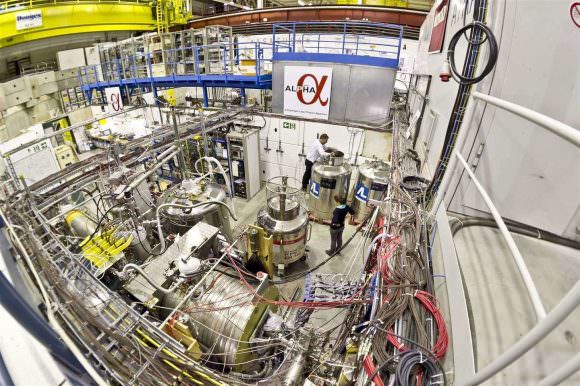One of the biggest mysteries in astronomy is the question, where did all the antimatter go? Shortly after the Big Bang, there were almost equal amounts of matter and antimatter. I say almost, because there was a tiny bit more matter, really. And after the matter and antimatter crashed into each other and annihilated, we were left with all the matter we see in the Universe.
You, and everything you know is just a mathematical remainder, left over from the great division of the Universe’s first day.
We did a whole article on this mystery, so I won’t get into it too deeply.
But is it possible that the antimatter didn’t actually go anywhere? That it’s all still there in the Universe, floating in galaxies of antimatter, made up of antimatter stars, surrounded by antimatter planets, filled with antimatter aliens?
Aliens who are friendly and wonderful in every way, except if we hugged, we’d annihilate and detonate with the energy of gigatons of TNT. It’s sort of tragic, really.
If those antimatter galaxies are out there, could we detect them and communicate with those aliens?
First, a quick recap on antimatter.
Antimatter is just like matter in almost every way. Atoms have same atomic mass and the exact same properties, it’s just that all the charges are reversed. Antielectrons have a positive charge, antihydrogen is made up of an antiproton and a positron (instead of a proton and an electron).
It turns out this reversal of charge causes regular matter and antimatter to annihilate when they make contact, converting all their mass into pure energy when they come together.
We can make antimatter in the laboratory with particle accelerators, and there are natural sources of the stuff. For example, when a neutron star or black hole consumes a star, it can spew out particles of antimatter.
In fact, astronomers have detected vast clouds of antimatter in our own Milky Way, generated largely by black holes and neutron stars grinding up their binary companions.

But our galaxy is mostly made up of regular matter. This antimatter is detectable because it’s constantly crashing into the gas, dust, planets and stars that make up the Milky Way. This stuff can’t get very far without hitting anything and detonating.
Now, back to the original question, could you have an entire galaxy made up of antimatter? In theory, yes, it would behave just like a regular galaxy. As long as there wasn’t any matter to interact with.
And that’s the problem. If these galaxies were out there, we’d see them interacting with the regular matter surrounding them. They would be blasting out radiation from all the annihilations from all the regular matter gas, dust, stars and planets wandering into an antimatter minefield.
Astronomers don’t see this as far as they look, just the regular, quiet and calm matter out to the edge of the observable Universe.
That doesn’t make it completely impossible, though, there could be galaxies of antimatter as long as they’re completely cut off from regular matter.
But even those would be detectable by the supernova explosions within them. A normally matter supernova generates fast moving neutrinos, while an antimatter supernova would generate a different collection of particles. This would be a dead giveaway.
There’s one open question about antimatter that might make this a deeper mystery. Scientists think that antimatter, like regular matter, has regular gravity. Matter and antimatter galaxies would be attracted to each other, encouraging annihilation.
But scientists don’t actually know this definitively yet. It’s possible that antimatter has antigravity. An atom of antihydrogen might actually fall upwards, accelerating away from the center of the Earth.

Physicists at CERN have been generating antimatter particles, and trying to detect if they’re falling downward or up.
If that was the case, then antimatter galaxies might be able to repel particles of regular matter, preventing the annihilation, and the detection.
If you were hoping there are antimatter lurking out there, hoarding all that precious future energy, I’m sorry to say, but astronomers have looked and they haven’t found it. Just like the socks in your dryer, we may never discover where it all went.


How can antimatter ‘galaxy’ or anything exist when everything repels everything if there can be a antimatter thing in the first place?!
Gravitons are attracted to other gravitons and would be repelled by antigravitons (if they exist) .
Conversely, antigravitons would be attracted to other antigravitons and repelled by gravitons.
The system has symmetry.
Likes attract and opposites repel.
“Likes attract and opposites repel.” — Be careful with this rule of thumb, especially in situations involving electrical charge. Positrons (anti-matter electrons) & electrons attract quite readily; the radiation they emit when they collide is what makes a PET scan work. In contrast, positrons & protons want nothing to do with one another, thanks to both being positively charged. Anti-hydrogen (1 positron, 1 anti-proton) can exist because, like regular hydrogen, each particle has a charge opposite the other.
As far as gravitons go, you’re right to add “if they exist;” there’s a Nobel Prize (at least!) waiting for the one(s) who can verify/falsify their existence.
Quote ‘If that was the case, then antimatter galaxies might be able to repel particles of regular matter, preventing the annihilation, and the detection’
Doesn’t this sound like the dark energy stuff pushing galaxies apart?
@Stephen Farrugia: That’s a mighty big “if” you’ve got there. =D
For macro-scale effects gravity does dominate, so a reasonably large clump of anti-matter MIGHT shove regular matter away via (anti-)gravity. However we don’t know yet because electro-magnetism is much more powerful than gravity on small scales: we haven’t been able to create enough anti-hydrogen (charge neutral) & then keep it around long enough to observe gravity’s effect on it. (I’ve heard we’re getting closer by the day, so I expect we’ll find out in a year or two at most.)
But even if anti-matter = anti-gravity, it would still have to clump together in amounts large enough to repel regular matter through this anti-gravity mechanism, & that seems unlikely in most places/times in the universe, meaning there’s almost certainly not enough to produce the effect we’re currently calling “dark energy.”
Hi Smokey,
You are correct, “The rule of thumb” for gravitational fields is opposite the rule for electric fields or magnetic fields.
I should have made that more clear that I was referring only to the subject at hand, gravitational fields.
Roger all, and no worries, was just seeking to clarify rather than “correct.” 🙂